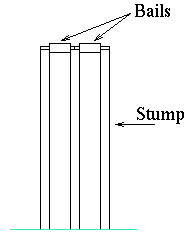- Cricket Ball:
- Hard, cork and string ball, covered with leather. A bit like a baseball (in size and hardness), but the leather covering is thicker and joined in two hemispheres, not in a tennis ball pattern. The seam is thus like an equator, and the stitching is raised slightly. The circumference is between 224 and 229 millimetres (8.81 to 9.00 inches), and the ball weighs between 156 and 163 grams (5.5 to 5.75 ounces). Traditionally the ball is dyed red, with the stitching left white. Nowadays white balls are also used, for visibility in games played at night under artificial lighting.
- Cricket Bat:
- Blade made of willow, flat on one side, humped on the other for strength, attached to a sturdy cane handle. The blade has a maximum width of 108 millimetres (4.25 inches) and the whole bat has a maximum length of 965 millimetres (38 inches).
- Wickets:
- There are two wickets - wooden structures made up of a set of three stumps topped by a pair of bails. These are described below.
- Stumps:
- Three wooden posts, 25 millimetres (1 inch) in diameter and 813 millimetres (32 inches) high. They have have spikes extending from their bottom end and are hammered into the ground in an evenly spaced row, with the outside edges of the outermost stumps 228 millimetres (9 inches) apart. This means they are just close enough together that a cricket ball cannot pass between them.
- Bails:
- Two wooden crosspieces which sit in grooves atop the adjacent pairs of stumps.
- A complete wicket looks like this:


No comments:
Post a Comment